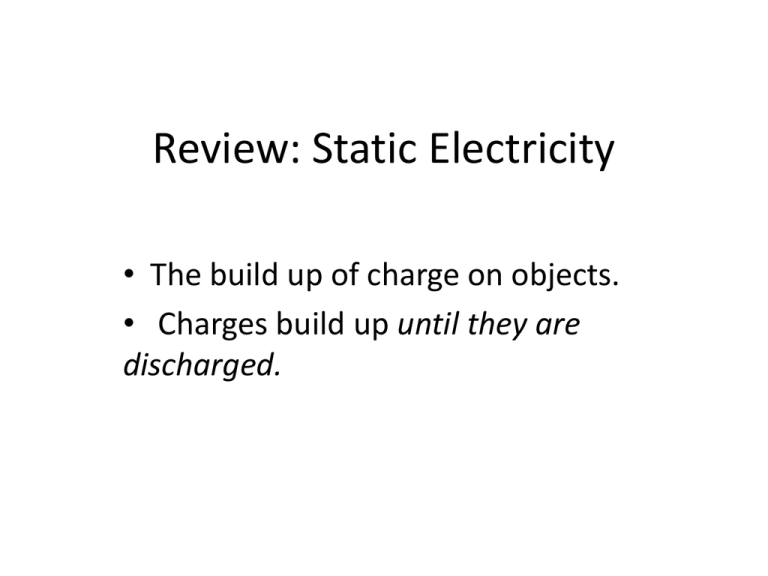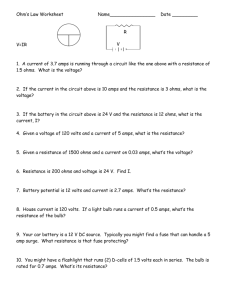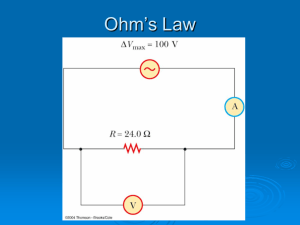Ohm*s Law
advertisement

Review: Static Electricity • The build up of charge on objects. • Charges build up until they are discharged. Review: Static Electricity Examples : • Charge accumulated on a balloon after it is rubbed on someone’s hair. • Electric shocks • Van de Graff generator • Lightning Electric Field • Electric charges affect other charges in the space around them. • Electric field depends on: 1. amount of charge that produces the electric field and • 2. the distance from the charge. Observing an Electric Field Write the following on your handout: 1. Google: Phet Circuit Construction Kit (do this 1st) 2. Google: Phet electric field hockey (do this 2nd) http://phet.colorado.edu/simulations/sims.php?si m=Electric_Field_Hockey • What affect do like charges have on each other? • What affect do unlike charges have on each other? If you have time to do electric field hockey, format your paper from our homework site as follows: Electric Field Hockey Level 1: sign off________ Level 2: sign off________ Level 3: sign off________ • Note: If there is more than one barrier, you must move the charge around every one. • http://public.rcas.org/hs/chs/chshomework/Pages/default. aspx Chapter 7: Current Electricity: 3 Variables: Ohm’s Law: V=Voltage (Volts) I=Current (Amps) R=Resistance (Ohms) Ohm’s Law V=IR (Volts)= (Amps) x (Ohms) What does Ohm’s Law mean? The water and pump analogy analogy for Ohm's Law: V=IR Voltage: Water pump that exerts pressure. Amps: Rate of flow of molecules of water. Ohms: Resistance provided by the tubing in the well. Voltage • Voltage is the electrical potential energy and is measured in volts. • We measure volts with a voltmeter. You will use an online voltmeter for this lab. • Once you open the faucet, the pressure causes the water to rush through the hose. Voltage (refer to p. 2 of lab hand out) • Voltage is like a ________ from a battery that makes a current flow. • It’s also called __________difference, or “____” for short. • We measure voltage with a _______ meter, and the units are called “Volts”. • We put our ___________ in parallel with the thing we’re measuring. Current (I) 1. Current indicates the number of electrons passing through the wire. 2. Current is measured in amperes, or amps for short. 3. The symbol I is used to indicate current. 4. The unit symbol for amps is A, as in 2.0 A. Current (I) Electrical current is similar to the rate of water flowing through a hose. Lab Hand out: Page 1 1. Current is the “flow” of electricity. 2. We measure current with an _________ and the units are called __________, or ______ for short. 3. We put our ammeter in _____________ with the thing we’re measuring. (demonstrate on Phet website). Resistance • Electrical resistance can be thought of as the "friction" on the movement of electrons in a wire. • Resistance is measured in ohms. (symbol Ω) • Thus 3 ohms is written as 3 Ω. Resistance • Most devices in an electrical circuit can be considered resistors, including light bulbs and electric motors. • Even the wire itself provides some resistance. Just as you get some heat from friction, electrical resistance also results in heat. That is why the light bulb filament gets hot and glows. Resistance • Following the water hose analogy, resistance is similar to the friction inside the hose. • Project on Elmo: – 1x5 cm2 rectangle, – 8x5 rectangle. – Which would you expect to have more resistance? – Short rectangle – Long rectangle – Which would you expect to have more resistance? • http://www.school-forchampions.com/science/elect_ohms_law.htm Ohm’s Law: Sample Problem • What is the voltage of a cell if • I=4 amps • R=3 ohms? • V=IR • V= 4 amps x 3 ohms • V= 12 volts Series Circuits: • Electrons move from the (-) pole to the (+) pole. • If the circuit is broken at any point, the current will not flow. • Demonstrate. Parallel Circuit • A parallel circuit has more than one pathway for electrons to flow. • If any circuit is broken to any branch, electrons will continue to flow through the remaining branches. • Demonstrate. Label Lab hand out • You may use schematic view or lifelike view. • Label batteries, ammeter, resistors (x), light bulbs. • Demonstrate: Click to show values. • Demonstrate: Click for ammeter, voltmeter. • If your circuit doesn’t work or starts on fire, x out and start over. Measuring amps • Use ammeter in series. • Demonstrate at Phet website: • http://phet.colorado.edu/simulations/sims.ph p?sim=circuit_construction_kit_dc_only Measuring volts • Use Voltmeter in parallel. • Demonstrate. • http://phet.colorado.edu/simulations/sims.ph p?sim=circuit_construction_kit_dc_only Phet Lab • Build the circuits on the hand out. • Use an ammeter to measure current in series and parallel circuits. Move it into each position and connect it in series. • Use a voltmeter to measure voltage in series and parallel circuits. Move the electrodes to measure voltage across any 2 points. • Record your values. Conclusion: • Determine how current and voltage vary in both series and parallel circuits. • Do this by taking measurements at designated points in the circuits you build at Phet and analyzing your results. • If you finish series and parallel circuit lab, you may do Phet: Electric Field Hockey for extra credit. Follow the format on our homework site. Get sign offs from Mr. Purcell and myself in class. If you need help building circuits from the schematic diagram: • Get your lap top and log on. • If you are ready to start, do so. • If you want to build a circuit with me, I will demonstrate again on the projector. Electric Circuit • • • • In an electric circuit, electric charges continuously travel though a closed loop. This flow of charges is known as electric current. A basic battery-powered electric circuit uses a battery to drive the current through a loop of wire. The battery provides a difference in electrical potential energy, or a voltage difference, often simply referred to as voltage. You can think of it as a difference in pressure: high pressure at one end of the battery and low pressure at the other. In the same way that a difference in water pressure pushes water through a pipe, creating a flow of water, a difference in voltage pushes electric charge through the wire, creating a flow of current through the circuit. The greater the voltage, the greater the current. When electric current flows through a material, it is likely to encounter resistance. Instead of traveling a direct path through the closed loop, charges may be scattered as they collide with the atoms of the material. Electrical resistance is a measure of how much the flow of electric charge is opposed in this way. The greater the resistance, the more difficult it is for current to flow. http://www.teachersdomain.org/resource/hew06.sci.phys.maf.ohmslaw/ If the pressure stays the same and the resistance increases (making it more difficult for the water to flow), then the flow rate must decrease:








